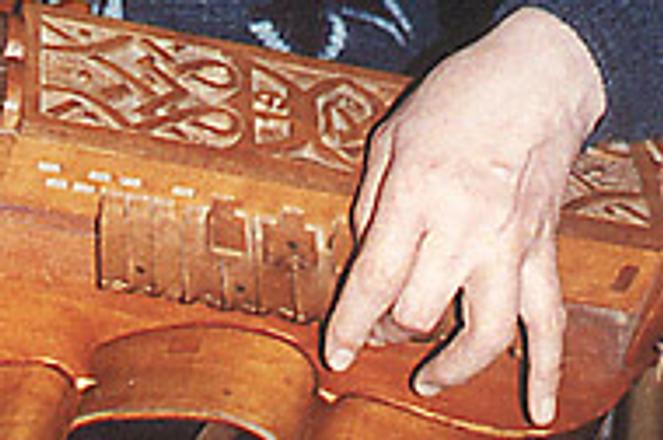Tibor Koblíček shows off his ninera, or hurdy-gurdy.photo: Ján Svrček
Craftsman Tibor Koblíček didn't make his first Slovak folk instrument until after his 30th birthday. Now, at age 63, he has trouble counting how many he can make.
"Whew," he says when asked, standing ankle-deep in sawdust, tools and half-finished instruments. "A heck of a lot."
Walking through his home in the central Slovak village of Turičky, population 250, Koblíček counts off at least 15 distinct names of instruments in piles seemingly everywhere. Last summer, Koblíček took 50 of these instruments to Slovakia's World Fair exhibit in Hanover.
"I was lucky," says Koblíček, leaning against a row of wooden pipes taller than he is. "They called me because they needed one person who could make all these instruments."
The World's Fair was the most recent honour for Koblíček, who has watched in the last decade as the fruits of what he calls a hobby and a passion became the stuff of museum exhibitions and a successful business. Technically retired, Koblíček works hours daily in a four-by-two metre workshop filling orders from Slovak folk ensembles, Slovak music shops, and international folk instrument collectors.
Koblíček's two-piped bagpipes differ from Scottish models.photo: Ján Svrček
The majority of those orders are for the píšťala, a small wooden recorder with up to six holes, gajdy, bagpipes made from goat pelts, and fujara, long wooden pipes sometimes compared to the Australian didgeridoo (a large wind instrument producing a deep, resonant sound) for their similar shape and timbre.
"The fujara is unique to central Slovakia, and is actually quite different than the didgeridoo. The didgeridoo doesn't have any holes and can't change pitch, whereas the fujara has three holes and can play two octaves," says Koblíček
Koblíček's career began in 1968 when a friend asked him to help make a fujara for a folk instrument contest. He enjoyed it so much that he learned a new type of instrument each year to make for the competition. He is still learning new instruments, and playing with the properties of those he has mastered.
"See this," he says, picking up what at first glance appears to be a walking stick. He then blows a tune through a head carved at the tip. "It's really a píšťala."
Although he has never had a formal teacher and can't read music, Koblíček can play every instrument he makes, and has travelled as a soloist to England, Egypt, Germany and Russia.
"I've been lucky," he says again, stepping over a six metre log waiting to be turned into a trumbita, or alpine horn. "Making instruments is my passion, and from that I've had the chance to see the world."
In recent years, Koblíček has played less but worked more to keep up with a growing demand.
"Since communism fell orders from abroad have increased, while domestic demand has stayed the same," he says. "I am twice as busy as I used to be."
Koblíček peddles his instruments at Slovak folk music festivals every summer and exhibits his work in Slovak museums. Foreigners - often collectors of instruments - are more and more often knocking on his door. In 1995 producers of the American film Dragonheart asked him for 15 lutes; recently an order came in from the makers of a different American film to be shot in Slovakia.
That order includes a ninera, or hurdy-gurdy (a musical instrument making a droning sound, played by turning a handle), which Koblíček learned to make in 1985 after no Slovak had made one for 150 years.
"As far as I know he is the only person in Slovakia who can make a ninera," says Ivan Macák, director of the Slovak National Music museum. "I brought him in 1985 to a Poprad museum to see Slovakia's only ninera. He took it home and learned how to make it."
Koblíček is passing his knowledge of the ninera and other instruments to his son, aged 33, who has worked for 10 years in what has become the family trade.
"He still has a lot to learn, but he's further along than I was at his age," says Koblíček. "When I was 33, I was just starting."


